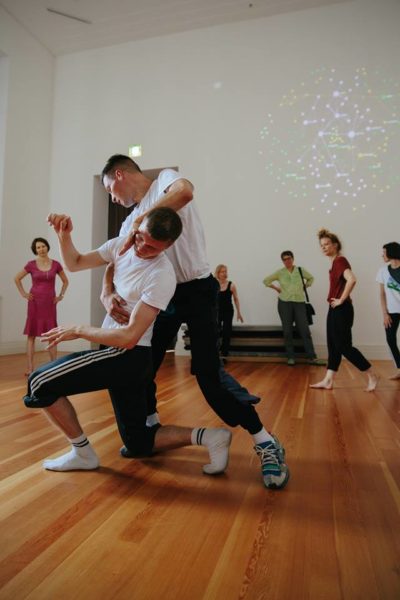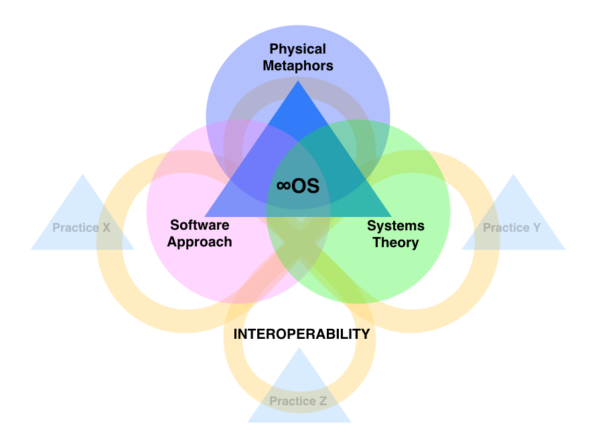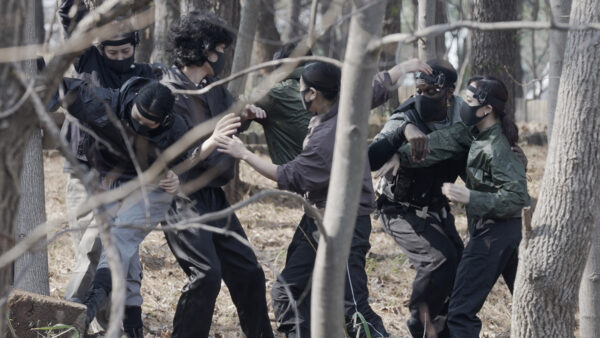EightOS / ∞OS is an open-source operating system for the bodymind. Its objective is to explore how the dynamics and behavior of natural systems can be modulated in physical, cognitive, and social realms. EightOS is concerned with the aesthetic, intuitive, and scientific understanding of this exploration. The key interest in EightOS practice is the notion of confluence — be it to another person, to a group, to space, or the environment — in order to create the conditions for adaptability, resilience, and evolutionary development to emerge.
While EightOS finds its expression as a physical, artistic, and cognitive practice it is strongly linked to technology. The “operating system” metaphor highlights the approach where the body is seen as the hardware and the habits, cultural patterns, behaviors, and beliefs are seen as the software. EightOS offers the tools and methodologies that can be used to reprogram this software, making references to disciplines ranging from Cybernetics to NLP. It does so by integrating physical movement into the process, forging a link between technological utopias and perfectionist training techniques.
However, efficiency and self-optimization are not the goals of the practice, which it purposefully avoids. Instead, the primary focus is on self-exploration and breaking existing patterns, decoupling personal value systems from the dominant capitalistic / gender hierarchies. Replacing straightforward, simplistic A-B, 1-0 approaches with a dynamics that is circular, iterative, rhizomatic, and fluid at its core.

The physical aspect of the practice is inspired by various movement practices ranging from Systema martial art to Noguchi Taiso gymnastics, contemporary dance, Butoh dance, Alexander technique, Vipassana meditation, Tai Chi, and movement therapies. EightOS is inspired by the fluid aesthetics of these practices and their interest in dealing with tension and relaxation. Unlike martial arts or therapeutic practices, however, it doesn’t seek a quick resolution of tension, but, rather, a prolonged exploration of the dynamics between tension and relaxation, which positions it more in the realm of dance. EightOS, therefore, is a practice of active introspection where the objective either does not exist at all or can be very fluid in nature.

The core principle of EightOS is a wave. We explore it on every scale: from physical movement to the organization of interaction dynamics and cycles of escalation / de-escalation. A build-up or escalation [1] is followed by conservation (assimilation) [2], which is followed by release [3], followed by reorganization (redirection and dissipation) [4], followed by a new process of escalation (response) [1] – like an ∞ (8). Each of these stages correlates to a certain scale and intent: alternating within the big / small scale spectrum (extrovert / introvert, high / log amplitude) as well as within the explore / focus (disrupt / connect, receptive / proactive) intent. Combining these different modalities and approaches in movement and attention helps induce highly adaptive dynamics, which can respond to events on multiple scales, be open to external influence and, yet, also impose certain dynamics on its surrounding.

The conceptual aspect of the practice takes inspiration from dynamical systems theory, network science, aerodynamics, and thermodynamics (especially fluid dynamics). All of these disciplines treat reality as a complex system where the whole is larger than the sum of parts and where processes occur in oscillations and waves. Multiple tools, instruments, and approaches have been developed in science to describe this sort of dynamics and we use their discoveries to explore mathematical language for describing and developing our work.

The human body like life itself has been shaped by evolution and contains many efficient strategies for dealing with the constantly changing world – both on the micro level (biology) and on the macro level (social dynamics). We distill and extract those principles and then systematize them into coherent frameworks, algorithms, and procedures, which can be applied in a variety of contexts: from everyday life and intersubjective relations to management and governance. EightOS, therefore, can be used as a tool for embracing a more ecological version of self-development where the focus is not so much on the final result, but, rather, on the process of developing an ecological relationship with yourself and others. Where ecology is not about the balance, but, rather, an acute awareness of the environment and the effects of one’s actions on larger ecosystems. The goal is not to avoid tension or conflict, but to, rather, use them as creative forces that can help shift a complex system to new state.

A very important aspect of EightOS practice is an educational approach that utilizes the notion of “transfer learning”. This notion was originally developed in the context of post-stroke recovery therapy and describes a step-by-step protocol for implementing behavioral patterns into everyday life. When we practice EightOS, we attempt to rewire our behavioral patterns using our physical bodies. We then model real-life situations outside of the physical context where similar patterns could be implemented to affect the dynamics of interaction and explore how these patterns could be implemented. A regular feedback mechanism is then used to estimate how effective these protocols are and how well the new behavioral patterns were integrated into everyday behavior.

Using technology and especially AI-powered motion tracking sensors we can better understand the dynamics of the experiences that we generate in real-time. We then use this feedback to choreograph our movement and engage in a symbiotic relationship with a machine, where an algorithm gets to be more “natural”, while whatever is natural is influenced by the machine. Therefore, EightOS and its corresponding algorithms can be used as choreographic devices and for collective movement practices. We applied this approach in numerous EightOS presentations, for example at Gwangju Biennale or Martin Gropius Bau.
In our lab sessions, we explore various physical, psychological, and behavioral patterns in order to challenge our limits and enhance our perception, endurance, and adaptability. We hack our own psyche and physicality, playing with it and surprising ourselves with new outcomes.
Much of the EightOS work is presented in the art context in the shape of immersive participative performances. We usually start a session by introducing a few sets of principles and movement patterns, which construct a common vocabulary for the participants. In the beginning, we keep the rules tight to create a safe space for practice. Gradually, we release the limitations adding more degrees of freedom, until our experience turns into a collective improvisatory dance where we can freely explore the principles of confluence and adaptive movement in relation to each other and to the space that we find ourselves in. These sessions always feel good and create a very special sense of conviviality that can only be attained through a collective physical experience and simultaneous presence in space. The participants are invited to join in with their bodies and to also observe as the aesthetic expression of movement is, perhaps, the best channel to fully get a sense of what EightOS is about. In our presentations, we seek to create temporary immersive environments where the principles of confluence, fluidity, resilience, and adaptability can unfold in relation to space and social bodies.
To learn more about EightOS basic principles and how they can be applied in real life, you can explore EightOS website at www.8os.io and join the Nodus Labs online course “∞OS Body/Mind Operating System: Learning to Modulate Conflict Dynamics”. EightOS also hosts regular online and offline sessions, which you can join if you subscribe to the EightOS newsletter.
…
More Information
Credits
Project, concept, and choreography by Dmitry Paranyushkin and Kirikoo Des
Photos by EightOS, Elke Walkenhorst, Adrian Kuenzel, Nailya Bikhmurzina
Videos by EightOS
Active During
2016 — present
Presented At
Gwangju Biennale (Korea), Martin Gropius Bau (Germany), Palais de Tokyo (France), Hyperwerk (Switzerland)
see a list of selected live presentations on this website
